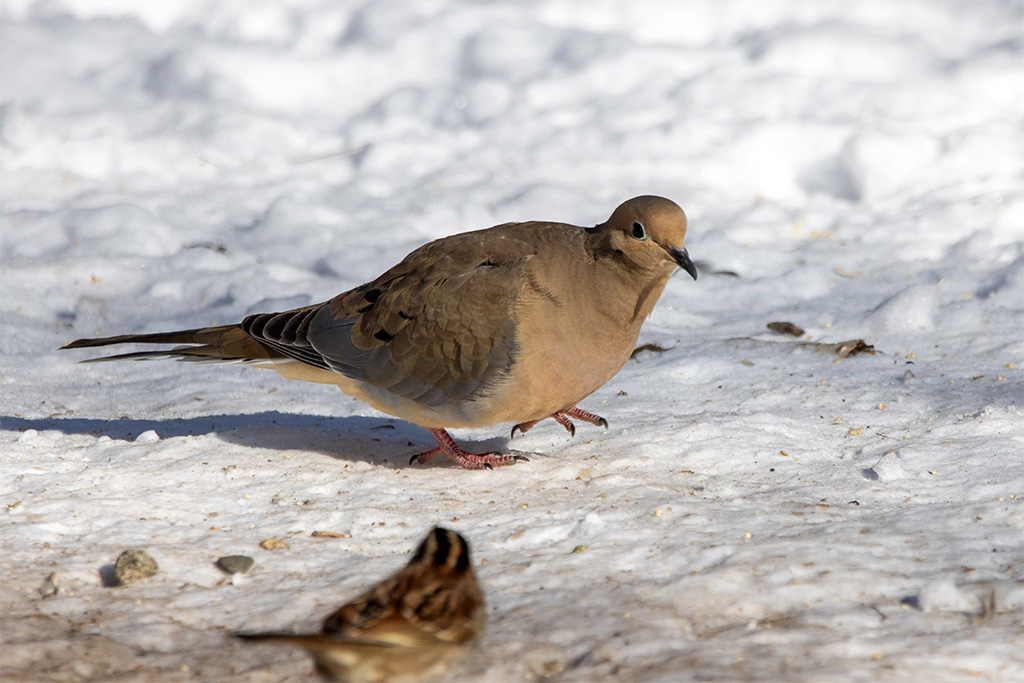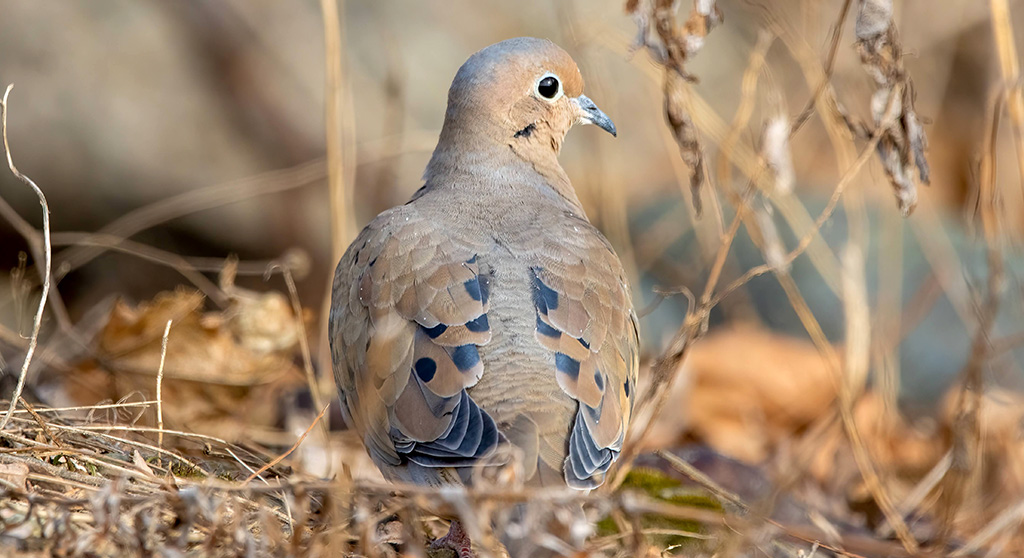Mourning doves have a mortality rate to cry over, but survive better than passenger pigeon cousins

Mourning Doves of both sexes are a mix of browns and grays with a few black spots. (Photo: Richard George)
The mourning dove (Zenaida macroura) is the only native North American bird that breeds in every single state, including Hawaii and Alaska. Although hunters kill more than 20 million to 70 million of these birds every year, thanks to their prolific breeding, there are more than 400 million mourning doves in the United States. In Massachusetts (as well as Vermont and New Hampshire), people do not hunt these birds because they are protected.
The mourning dove, which used to be called the turtle dove, eats seeds almost exclusively and forage for them on the ground, often congregating below bird feeders where they can find the seeds other birds have spilled. They are partial to sunflower seeds, millet, cracked corn, and wheat, but are not fussy and eat the widest range of seed types of any North American bird.

Mourning doves prefer open habitats such as yards, parks, open woods, grasslands and farms. (Photo: Jeanine Farley)
Most migrate south at different times depending on age and sex, starting with the youngest in late August and September, then the females and finally the migrating males depart. Some males stay so they will have first crack at claiming a good breeding territory in the spring. Thanks to backyard bird feeders, overwintering males have become more and more common. But they are not adapted to our harsh winters, and sometimes sport frostbitten toes or missing toenails.

Some mourning doves brave our Cambridge winters, as exemplified by this Huron Village bird in January. (Photo: Richard George)

Overwintering mourning doves survive by finding seeds, often beneath bird feeders. They do not dig or scratch for seeds and eat only what is visible. (Photo: Richard George)
At almost any time of the year except the winter, female mourning doves lay two eggs in a nest, which she builds on a horizontal surface – usually a tree branch or a bush, but sometimes on lawn furniture or even the upturned head of a push broom. Both males and females incubate the eggs, but the female spends about three times as much time sitting on the nest as the male, who sits from midmorning to midafternoon. In his 21-volume work, Life Histories of North American Birds, Arthur Cleveland Bent quotes J. L. Davidson from Forest and Stream:
The male took up his duties at the nest at about 10 in the morning and was relieved again at about 3 in the afternoon. The male often left the eggs unguarded for a few minutes about noon while he flew to a nearby watering place to drink.

Mourning doves are prolific breeders but have high mortality rates: up to 70 percent for doves less than a year old and 60 percent for adult birds. (Photo: Richard George)
The hatchlings, called squabs, are fed by both parents. They get crop milk, nutritious protein- and fat-rich curds made of cells sloughed off from the crop, which is a pouch on the front of the bird’s neck. To reach this “milk,” squabs stick their heads into the open mouth of a parent and eat the food directly from the crop. If one of the parents dies before the hatchlings are a week old, the squabs will die, too, because one parent cannot produce enough crop milk to feed both hungry hatchlings. The squabs grow quickly and fledge in only two weeks. Mourning doves are attentive parents, and one parent or the other is always at the nest from the time the first egg is laid until the young leave the nest. Even after they leave the nest, the father feeds the fledglings for up to two weeks.

Mourning doves are one of the few types of birds that drink by sucking up water. They can suck up their total daily water needs in fewer than 20 seconds. (Photo: Richard George)
Although their diet is 99 percent seeds, these birds also eat sand and small pebbles called grit, which collects in a part of the stomach called the gizzard. In the gizzard, the grit grinds seeds into smaller, more digestible bits. From the gizzard, food passes into the small intestine, where nutrients are absorbed. It has been estimated that a mourning dove needs to consume 60 to 100 pieces of grit each day to replace what is worn down in the gizzard. That’s a lot of grinding!
In the 1800s, the “turtle dove” was not common in Massachusetts. In fact, the bird was imperiled because hunters captured the birds in the same nets they used to capture passenger pigeons. And we all know what happened to passenger pigeons – which, by the way, are very closely related to mourning doves and look similar.

Most mourning doves have a black or gray spot on their cheeks. (Photo: Brian Rusnica)
Cotton Mather, the Puritan clergyman who had a leading role in the Salem witch trials, said in 1712 about a flight of passenger pigeons:
Sometimes we have mighty Flocks of those Pigeons flying over us; thousands in a Flock; [the] best part of a mile square occupied by a Flock … several Hours have run out, before [the] appearance of these Birds … have been over.
Scientists think passenger pigeons numbered 3 billion to 5 billion when Europeans arrived, and that these birds made up 25 percent to 40 percent of the total bird population of the United States. In the 1800s, professional hunters began slaughtering them to sell in city markets. In 1878, for example, professional hunters in Michigan killed 50,000 nesting passenger pigeons per day for almost five months!

Mourning doves are often spotted in pairs; this couple graced North Cambridge. (Photo: Richard George)
It’s not surprising that by the early 1900s all the wild passenger pigeons were gone, although people sometimes mistook mourning doves for passenger pigeons, leading to false reports of the birds being alive after they were actually extinct. The effects of the slaughter made people aware of the need to pass bird conservation laws such as the Migratory Bird Act. They now protect many birds, including the mourning dove, from the fate of the passenger pigeon.
In the 1900s, mourning doves began expanding their range into Massachusetts, and today can be found in almost all of the state. Mourning doves were named for the mournful cooing sound they make. Turtle doves were also named for this sound, only the sound was represented as turr-turr-turr rather than the coo-coo-coo we think of today.

When sleeping, these doves do not tuck their head under the shoulder feathers as many other birds do. (Photo: Jeanine Farley)
![]()
Have you taken photos of our urban wild things? Send your images to Cambridge Day, and we may use them as part of a future feature. Include the photographer’s name and the general location where the photo was taken.
Jeanine Farley is an educational writer who has lived in the Boston area for more than 30 years. She enjoys taking photos of our urban wild things.



Great photographs with this informative artic,e. Thanks.